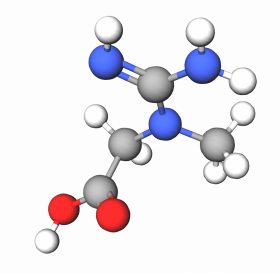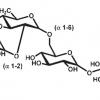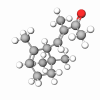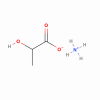Creatine is an amino acid derivative (non-proteinogenic amino acid known as Methylguanidoacetic acid) found naturally in the skin. It acts as an energy reservoir essential for the energy supply and function of the cells, participating in ATP production, a universal fuel molecule, like a kind of intracellular accumulator that can be recharged, providing fuel on-demand and improving the cells' energy system.
The body produces creatine from two amino acids, glycine and arginine. However, the production of methylguanidoacetic acid declines with aging; that's why it makes sense to administer it externally to the skin, energizing it and boosting metabolism. Besides energizing action, creatine soothes and moisturizes the skin, exposing excellent care properties for an active ingredient.
Anti-aging effect
Due to its constant exposure to the environment, the skin has to cope with various irritating and stressful factors such as pollution, exposure to solar radiation, and, consequently, UV light. Skin cells have natural protective and repair mechanisms, which can reverse cellular damage. The cellular pool of antioxidants and enzymatic repair systems for damaged proteins are among these. However, during chronological aging, the skin's response to environmental challenges is impaired, which results in a decreased repair capacity to injury. These age-related functional deficiencies of human skin cells are amplified in photo-aged cells.
A highly efficient personal care ingredient with a focus on anti-aging action
Creatine is an amino acid derivative naturally occurring in the human body. The methylguanidoacetic acid is trapped by phosphorylation catalyzed by the enzyme creatine kinase in the cell's cytosol. Consequently, a significant amount of the creatine stored in the cells is phosphorylated. The so-called "phosphocreatine" plays a pivotal role in cellular energy metabolism because of the regeneration of the cellular energy source ATP (Adenosine triphosphate). So, phosphocreatine functions as an "energy buffer" during phases of enhanced energy requirement.
The energy required to live is produced efficiently in cellular organelles called mitochondria. Consequently, an increase in creatine and phosphocreatine content will boost the efficiency of the mitochondria.
The Cell Energizing Effect of Creatine
Due to its cell-energizing effect and ability to penetrate the skin, the topical application of creatine should improve the skin cells' energy metabolism. A deep stimulation of the mitochondrial activity should be expected as an effect. An XTT assay with cultured human keratinocytes was performed to confirm this hypothesis. The test validated that the vitality of the cells treated with this energizing ingredient was enhanced.That "cell energizing effect" finally causes an increase in the cellular protein content, which was proven by the performance of a spectrophotometrical protein assay (Method of Bradford). It was found that creatine can raise protein synthesis to ten-fold.
Efficacy on UV-Damaged Skin Cells
It is well known that modulated ATP levels can influence the loss of the DNA synthesis capacity of cells. Due to its cell-energizing effect, creatine stimulates DNA re-synthesis in cells damaged by UV irradiation. The effect has been evaluated on UV-irradiated skin cells. Methylguanidoacetic acid can significantly reduce the number of sunburn cells induced by UV irradiation.
Additional Benefits
Besides the cell energizing effect, methylguanidoacetic acid can protect the skin against irritation by preventing the damage of cell membranes. Skin irritation caused by several environmental factors can be alleviated. These effects of creatine could be demonstrated via a modified red blood cell test. The efficacy of methylguanidoacetic acid to reduce hemolysis could be clearly shown, and damaging effects caused by surfactants are mitigated in cells preconditioned with methylguanidoacetic acid.Creatine functions are likely an osmoprotectant (compatible solute) that can aggregate large hydration shells. It can shield bio-molecules such as proteins, biomembranes, and nucleic acids by forming strong water structures. Due to its structural similarity to classical osmoprotectants such as L-arginine at the molecular level, methylguanidoacetic acid can accumulate water to improve the skin's moisture and protect the cells against hazardous influences.
Conclusion
Topical application of creatine on aging, stressed, or UV-damaged skin improves the skin's appearance. Consequently, the skin becomes firmer, and lines and wrinkles are reduced. These features make methylguanidoacetic acid a versatile additive for incorporating into various personal care products.











